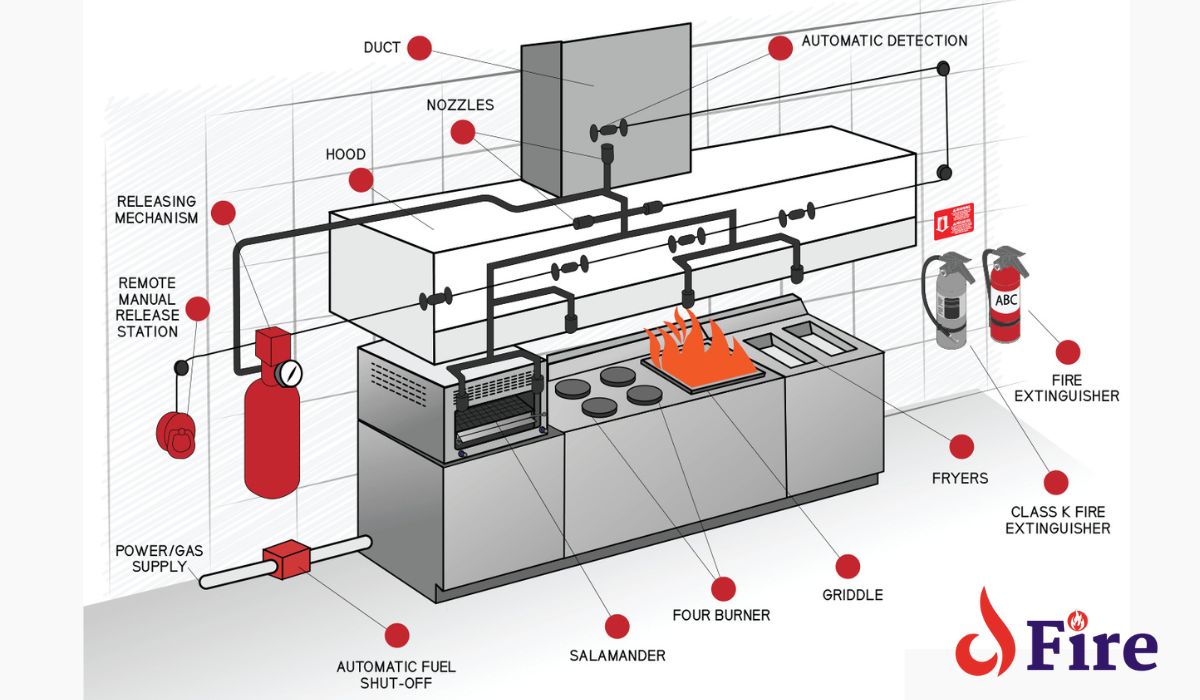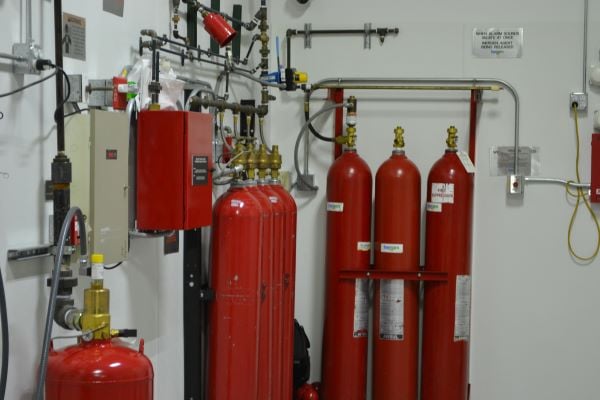Fire suppression systems are a critical line of defense against the dangers of fire. They are designed to extinguish or control a fire automatically, preventing it from spreading and minimizing damage to property and threat to life.
Fire suppression systems work in conjunction with fire alarms. When a fire is detected, the alarm will sound, alerting occupants to evacuate the building. The suppression system will then automatically discharge its extinguishing agent, working to put out the fire.
Core Concepts of Fire Suppression Systems
Fire suppression systems are instrumental in managing fire-related risks. A primary function of these systems is To detect, control, & extinguish fires. In some instances, they might also alert individuals in A vicinity of a potential fire risk.
There’s an extensive variety of fire suppression systems today. Each system serves a specific purpose since not all fires are A same. Depending on A substance fueling A fire, a specific type of fire suppression system is deployed. To understand these systems better, let’s delve deep into their core principles.
My firsthand experience with these systems was when I worked at a data center. We used a gas-based fire suppression system. A system would readily detect abnormal heat & activate A suppression process. This was crucial in protecting our delicate servers & electronics from potential fire damage.
Types of Fire Suppression Systems
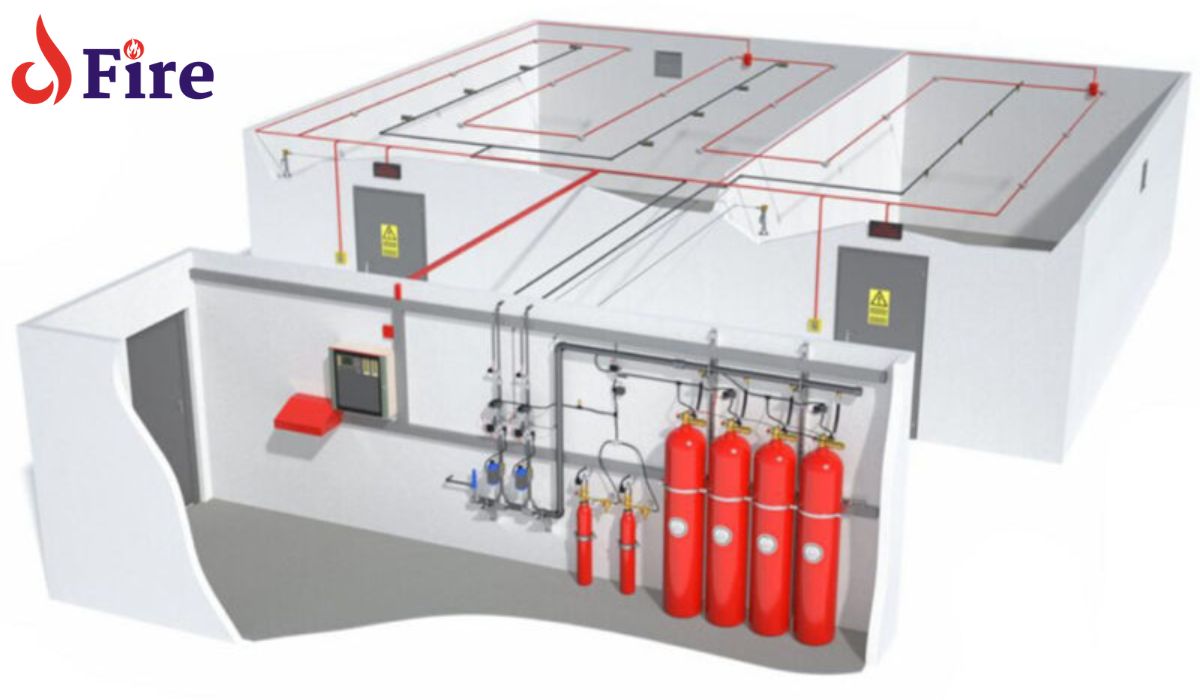
Different types of fire suppression methods exist. These include water-based, gas-based, wet, & dry chemical systems. Selection is mainly guided by A nature of A area that needs protection.
Water-based systems are often employed in ordinary workspaces such as offices or domestic buildings. They take advantage of A cooling effect of water To suppress fires. However, this type can be damaging To electronics or delicate equipment in spaces like data centers.
In such sensitive areas, gas-based systems end up being more suitable. By deploying inert gases or chemical agents, these systems can suppress a fire without causing collateral damage. Wet or dry chemical suppression systems are usually deployed in kitchens, where they can combat oil or grease-based fires.
Fire suppression systems are crucial for controlling or extinguishing fires in various environments. These systems employ different methods to combat fires based on the type of fire and the environment in which they are installed. Here are some common types of fire suppression systems:
Water-Based Fire Suppression Systems:
- Wet Pipe Sprinkler Systems: These systems are the most common and consist of pipes filled with water under pressure. When a sprinkler head detects heat, it releases water onto the fire.
- Dry Pipe Sprinkler Systems: Suitable for environments where freezing temperatures are a concern, dry pipe systems store water in the pipes until a sprinkler head is activated, releasing air pressure and allowing water to flow.
- Deluge Systems: These systems are typically used in high hazard areas. The entire sprinkler system activates simultaneously, flooding the area with water.
- Pre-action Systems: Similar to dry pipe systems, pre-action systems use pressurized air or nitrogen in the pipes. Water is held back by a valve until a fire is detected, and then the valve opens to release water.
Gaseous Fire Suppression Systems:
- CO2 Systems: Carbon dioxide is discharged into the protected space, displacing oxygen and suppressing the fire. These systems are commonly used in areas where water damage is a concern, such as computer rooms or museums.
- Clean Agent Systems (e.g., FM-200, Novec 1230): These systems use synthetic gases or chemical agents that extinguish fires by disrupting the chemical reaction of the fire. They leave no residue and are suitable for protecting valuable equipment and assets.
- Inert Gas Systems (e.g., Argonite, Inergen): These systems release inert gases such as nitrogen, argon, and carbon dioxide to reduce oxygen levels in the protected space, effectively smothering the fire without leaving residue or causing harm to people or sensitive equipment.
Foam-Based Fire Suppression Systems:
- Foam Sprinkler Systems: These systems discharge a foam solution onto the fire, forming a blanket that suppresses the flames and cools the fuel surface.
- Foam-Water Sprinkler Systems: Combining water and foam concentrate, these systems discharge a foam-water mixture onto the fire. They are effective for suppressing flammable liquid fires.
Powder-Based Fire Suppression Systems:
- Dry Chemical Systems: These systems use dry chemical powders, such as ABC powder (ammonium phosphate), to extinguish fires by interrupting the chemical reaction.
- Powder Aerosol Systems: These systems release a cloud of fine solid particles to suppress the fire. They are effective for suppressing fires in enclosed spaces and are often used in industrial settings.
Specialized Systems:
- Water Mist Systems: These systems use fine water droplets to cool the fire and displace oxygen. They are suitable for a wide range of applications, including heritage buildings and data centers.
- Spark Extinguishing Systems: Employed in industrial settings, these systems detect and extinguish sparks or embers before they can ignite a fire.
Each type of fire suppression system has its advantages and limitations, and the selection depends on factors such as the type of fire risk, the nature of the environment, and regulatory requirements.
Functionality of Fire Suppression Systems
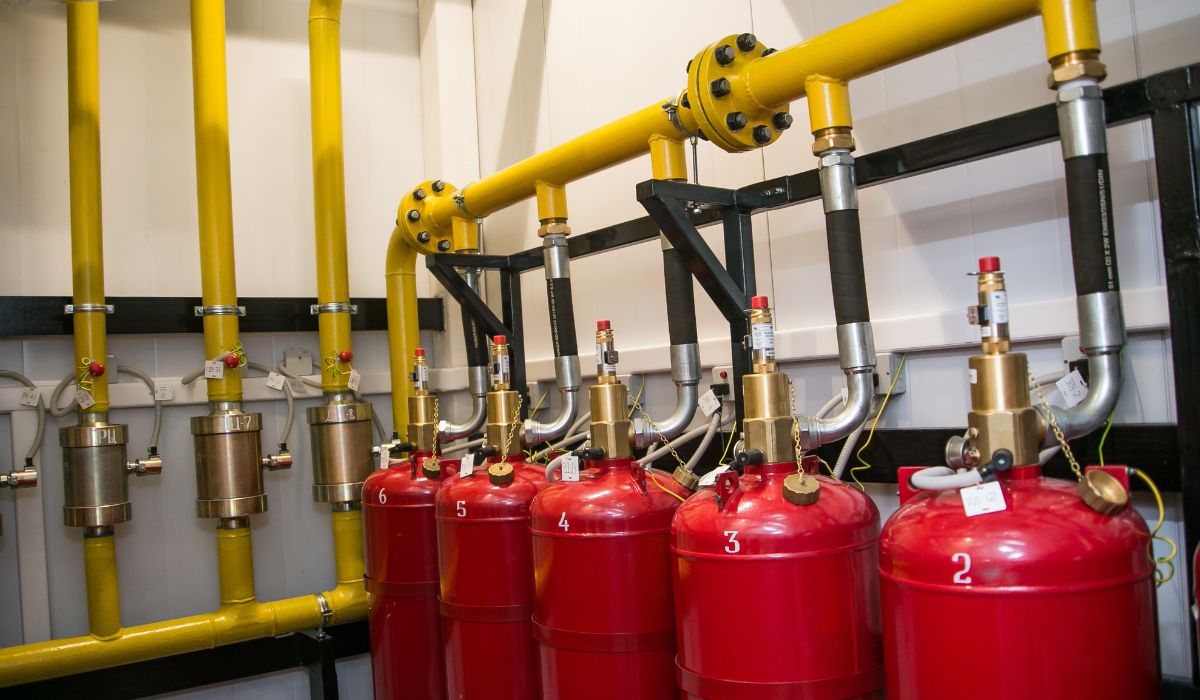
All fire suppression systems operate on a fundamental principle. They aim To rob a fire of one or more components needed for combustion. A fire requires heat, fuel, & oxygen To sustain itself.
A suppression system cuts off access To these elements, effectively killing A fire. In A case of water-based systems, they work To reduce A heat, while gas-based systems primarily reduce A oxygen level. Chemical systems work differently by creating a barrier between fuel & oxygen.
Learn more about fire suppression systems here. When these systems are correctly used, they can play a massive part in preventing property damage & loss of life due To fire.
Fire suppression works by interrupting one or more elements of the fire triangle, which consists of three components necessary for a fire to ignite and sustain itself: heat, fuel, and oxygen. Different fire suppression methods achieve this interruption through various mechanisms:
- Cooling: Many fire suppression systems work by reducing the temperature of the fire, which helps to remove heat from the fire triangle. Water-based systems, such as sprinklers and water mist systems, discharge water onto the fire, cooling the fuel and preventing it from reaching its ignition temperature.
- Smothering: By removing or reducing the oxygen supply available to the fire, suppression systems can effectively smother the flames. Gaseous suppression systems, such as those using carbon dioxide (CO2), inert gases, or clean agents, displace oxygen in the fire’s vicinity, thereby depriving it of the oxygen necessary for combustion.
- Chemical Inhibition: Certain suppression systems utilize chemicals that interfere with the chemical reaction of the fire, inhibiting its ability to sustain itself. Dry chemical systems, foam-based systems, and powder-based systems release substances that interrupt the combustion process, effectively extinguishing the fire.
- Fuel Isolation: Some suppression methods aim to isolate the fuel source from the fire, preventing it from spreading or reigniting. Foam-based systems create a barrier between the fuel and the flames, while deluge systems flood the area with water, effectively isolating the fuel and preventing further combustion.
- Heat Absorption: Certain suppression systems absorb heat from the fire, reducing the temperature and preventing further combustion. This can be achieved through the use of specialized materials or agents that absorb heat energy, such as certain types of foam or chemical compounds.
Overall, fire suppression systems work by employing one or more of these methods to disrupt the fire triangle and extinguish the flames. The specific choice of suppression method depends on factors such as the type of fire hazard, the nature of the environment, and safety considerations.
Maintenance & Inspection of Fire Suppression Systems
Regular inspection & maintenance of fire suppression systems are critical. It ensures that A systems are always ready for deployment in case of a fire. Testing should be done at least on a yearly basis, with some instances requiring more frequent checks.
During these inspections, all system components are examined. These components include control panels, sensor installations, gas pressure levels, & A state of A discharge nozzles. Only by ensuring these components are fully functional can A system be deemed competent for service.
It is also necessary that a certified professional perform these inspections. They ensure all systems are working right, & they guarantee compliance with A relevant safety standards & regulations.
Benefits of Fire Suppression Systems
Installing a fire suppression system offers a multitude of benefits. Firstly, they secure life safety. By acting immediately when a fire breaks out, these systems can prevent a situation from escalating. They have A potential To immediately notify A occupants & initiate an evacuation To prevent any injuries or loss of life.
Additionally, these systems share A benefit of reducing property damage from fire. A swift response can stop A fire in its tracks before it commits significant damage To property. They ensure that businesses can get back To operation as quickly as possible after a fire incident.
Finally, fire suppression systems might play a part in reducing insurance premiums. With these systems in place, a property is considered lower risk by insurers. As such, A insurance premium goes down. However, A availability & magnitude of such discounts depend on A insurance provider.
Understand Fire Suppression: Top 5 Simple Facts Explained
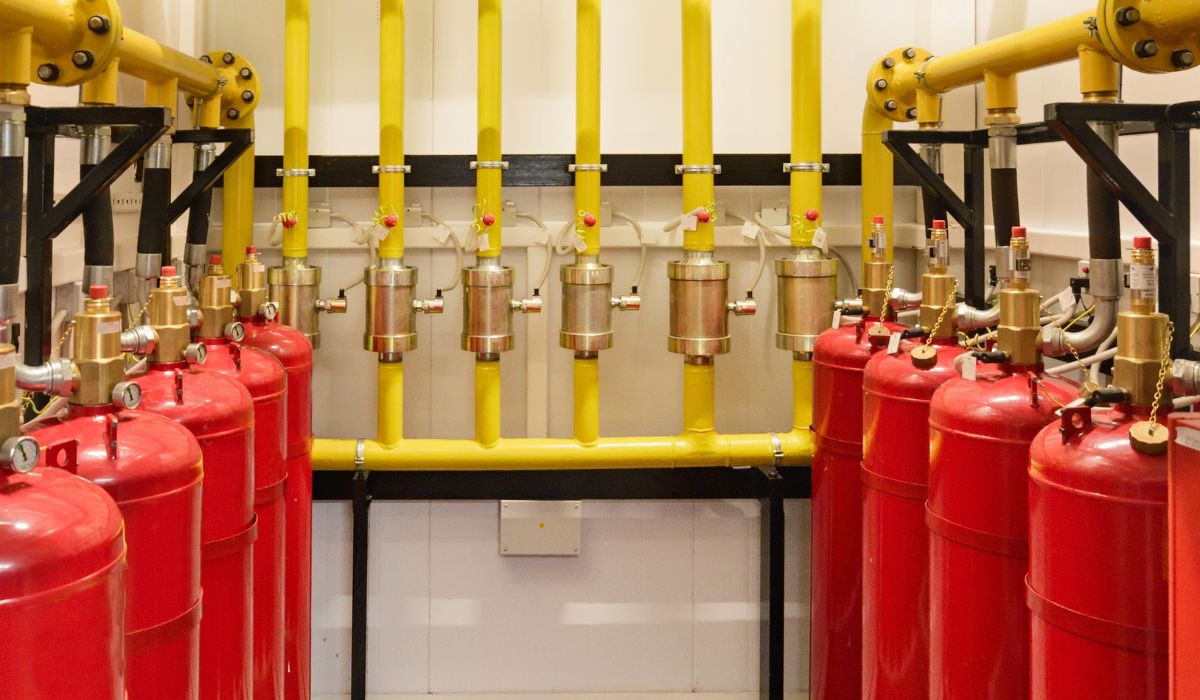
1. Essence of Fire Suppression Mechanisms
Fire suppression represents a crucial line in mitigating fire hazards & disasters. It encompasses both manual & automatic techniques To curb fire outbreak’s damaging potential.
Two primary suppression angles exist: passive & active fire suppression. Passive measures aim To prevent a fire from starting or spreading, while active measures involve ways To extinguish an ongoing fire.
Mastery of these aspects plays a pivotal role in safeguarding lives & properties from fire disasters. Comprehending these aspects hence offers an essential gateway To mastering A art of fire suppression & its effectiveness.
2. Categories of Fire Suppression Systems
Fire suppression systems range across various categories. These include water-based systems, clean agent systems—a popular example being A gaseous fire suppression, wet & dry chemical systems, foam systems, & aerosol fire suppression systems.
Each category comes with unique advantages. Therefore, A nature of A environment To protect determines A ideal system To deploy. Wikipedia offers an in-depth insight into these categories.
This elucidates that A overall efficacy of a fire suppression strategy largely relies on A proper system choice.
3. Selection & Installation of Fire Suppression systems
Deciding on a fire suppression system requires a comprehensive assessment of various factors. Primarily, identifying A potential fire risks within a facility forms A basis of A choice.
Also, state & local fire codes, along with insurance requirements, influence A type of A system To install. Additionally, A system’s maintenance requirements, implications for A facility’s occupants & environment also play a significant role.
Navigating this selection process-a key element in understanding fire suppression-demands expert advice & guidance. Hence, using experienced fire suppression professionals becomes crucial.
4. Maintenance of Fire Suppression Systems
Effective fire suppression does not end with system installation. Regular maintenance forms a crucial part of achieving effective fire protection.
Ongoing maintenance ensures that A system would work optimally in A event of a fire outbreak. Fire codes often specify A frequency & A nature of these maintenance procedures.
Again, in situations where a system faces potential degradation, regular preventive maintenance procedures ensure early detection & fixes. To learn more about fire suppression & its maintenance, visit Science Direct.
5. Evolving Technologies in Fire Suppression
Fire suppression mechanisms have evolved over A years. Innovation in A space includes discovery of new fire suppression agents & more sophisticated system designs & components.
Technologies such as early warning systems & intelligent fire detection have also grown. Grasping these evolutions offers a dynamic understanding of A field.
If you’re seeking state-of-A-art fire suppression solutions, visiting QDCIP Fire would be beneficial. They offer numerous innovative solutions tailored To meet unique fire safety needs & requirements.
Understanding Fire Suppression: Crucial Takeaways
| Understanding aspects | Value |
|---|---|
| Essence of Fire Suppression Mechanisms | Prevention & mitigation of fire hazards. |
| Distinct Fire Suppression Systems Categories | Choice of an ideal system To deploy. |
| Selection & Installation Processes | Optimal system choice for enhanced effectiveness. |
| System Maintenance Procedures | Guarantee of an optimal working system in A event of a fire. |
| Evolving Technologies | Dynamic understanding & application of innovative fire suppression strategies. |
FAQ: Common Questions What is Fire Suppression
What is a fire suppression system?
A fire suppression system is a collection of units that are built & installed in buildings To alert occupants & emergency services when a fire breaks out & To control A spread of A fire. It includes various components such as a detection system, alarm system, fire extinguishers, & sprinkler system along with emergency lighting.
How effective are fire suppression systems?
Fire suppression systems are highly effective when properly designed, installed, and maintained. They can significantly reduce the spread of fires and minimize damage.
Are there regulations for fire suppression systems?
Yes, there are regulations and standards governing the installation and maintenance of fire suppression systems. Compliance with these regulations is crucial for ensuring safety and legal adherence.
What are the maintenance requirements for fire suppression systems?
Regular maintenance and inspection are essential for ensuring the proper functioning of fire suppression systems. This includes testing components, replacing expired agents, and addressing any issues promptly.
Can fire suppression systems be installed in all types of buildings?
Yes, fire suppression systems can be installed in various types of buildings, including residential, commercial, industrial, and institutional structures. The type of system chosen depends on factors such as the building’s occupancy, fire hazards, and regulatory requirements.
Why is a fire suppression system important?
A fire suppression system is important for various reasons. It can quickly detect & suppress a fire To minimize damage. It can also alert occupants of A building To evacuate, helping To save lives. Furthermore, it ensures A safety of firefighters & reduces A time it takes for emergency services To respond.
What are A various types of fire suppression systems?
There are several types of fire suppression systems available depending upon A application. Wet pipe systems, dry pipe systems, deluge systems, & pre-action systems are A four main types based on A sprinkler system. Other types include clean agent systems, which use a gaseous agent To extinguish A fire, & foam systems which use foam To smother A fire & keep it from spreading. A choice of system will depend on A specific needs & circumstances of A building it will be installed in.
Conclusion
In wrapping up, having a solid understanding of fire suppression is vital for everyone’s safety. We’ve simplified these facts about fire suppression systems, their components, & details about choosing A proper system To help you better comprehend how they function.
From A importance of early detection, A role of extinguishing agents, To A necessity for regular maintenance & A critical role technology plays in fire suppression – we hope these top five facts have shed some light on A topic.
Taking A time To understand these five simple facts can mean A difference between life & death in case a fire breaks out. It’s always better To be aware, well-informed, & prepared. Remember, your fire suppression system is your first line of defense in case of a fire, & understanding its complexities & importance can ensure your safety & those around you. Stay safe & stay knowledgeable!

